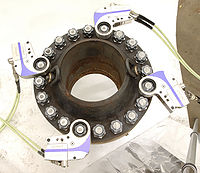
Hydraulic torque wrench
Encyclopedia



Tool
A tool is a device that can be used to produce an item or achieve a task, but that is not consumed in the process. Informally the word is also used to describe a procedure or process with a specific purpose. Tools that are used in particular fields or activities may have different designations such...
designed to exert torque
Torque
Torque, moment or moment of force , is the tendency of a force to rotate an object about an axis, fulcrum, or pivot. Just as a force is a push or a pull, a torque can be thought of as a twist....
on a fastener
Fastener
A fastener is a hardware device that mechanically joins or affixes two or more objects together.Fasteners can also be used to close a container such as a bag, a box, or an envelope; or they may involve keeping together the sides of an opening of flexible material, attaching a lid to a container,...
to achieve proper tightening or loosening of a connection through the use of hydraulics
Hydraulics
Hydraulics is a topic in applied science and engineering dealing with the mechanical properties of liquids. Fluid mechanics provides the theoretical foundation for hydraulics, which focuses on the engineering uses of fluid properties. In fluid power, hydraulics is used for the generation, control,...
. A torque wrench
Torque wrench
A torque wrench is a tool used to precisely apply a specific torque to a fastener such as a nut or bolt. It is usually in the form of a socket wrench with special internal mechanisms. It was invented by Conrad Bahr in 1918 while working for the New York City Water Department...
is applied to the nut either directly or in conjunction with an impact socket. Hydraulic torque wrenches apply a predetermined, controlled amount of torque to a properly lubricated fastener. The hydraulic torque wrench was invented by George A. Sturdevant in Houston, Texas
Houston, Texas
Houston is the fourth-largest city in the United States, and the largest city in the state of Texas. According to the 2010 U.S. Census, the city had a population of 2.1 million people within an area of . Houston is the seat of Harris County and the economic center of , which is the ...
. The concept of a hydraulic powered torque wrench was first introduced on the market sometime in the early 1960s in a primitive form, and several key advances have been developed by manufacturers since that time which provided major advancements in the technology and usability of the tools far beyond the original concept tool. Today's tools offer benefits such as lighter weights, smaller nose radius dimensions for fitting into tight spaces, use of exotic alloys, actuation triggers on the tool itself, multi-position reaction members, 360° x 360° hose swivels, and the ability to run multiple tools simultaneously from a single power pack.
The main characteristics of a hydraulic torque wrench which set it apart from other powered wrenches of similar function are that (1) it must generate torque using only hydraulic means (2) it must be self ratcheting, and (3) it must include an accurate method of determining the amount of torque applied. Some manufacturers utilize a holding pawl design to keep the wrench locked in position prior to each power stroke, others use varying designs, which as in all industries have debatable faults or claimed advantages. Hydraulic torque wrenches typically offer accuracy of +/- 3% and have a high degree of repeatability making them well suited to applications where large bolts are involved and a high degree of accuracy is required. A hydraulic torque wrench is significantly quieter, lighter weight and more accurate than pneumatic impact wrenches capable of similar torque output, making it an appealing alternative for many users to the very loud and cumbersome impact wrenches or torque multipliers which were formerly the only viable option for working with very large nuts and bolts until the hydraulic torque wrench was introduced.
See also
- Electric torque wrenchElectric torque wrenchAn electric torque wrench is a planetary torque multiplier or a "Gearbox". This gearbox is mated to an electric motor. At the end of the "gearbox" is a reaction device that is used to absorb the torque...
- Pneumatic torque wrenchPneumatic torque wrenchA pneumatic torque wrench is a planetary torque multiplier or a gearbox that is mated to a pneumatic air motor. At the end of the gearbox is a reaction device that is used to absorb the torque and allows the tool operator to use it with very little effort...
- Power toolPower toolA power tool is a tool that is actuated by an additional power source and mechanism other than the solely manual labour used with hand tools. The most common types of power tools use electric motors. Internal combustion engines and compressed air are also commonly used...
- Socket wrenchSocket wrenchA socket wrench is a wrench with interchangeable heads called sockets that attach to a fitting on the wrench, allowing it to turn different sized bolts and other fasteners. The most common form is a hand tool popularly called a ratchet consisting of a handle with a ratcheting mechanism built in,...

